Table of Contents
Greetings from the Romanian librarians
1 The Evolution of Romanian libraries and librarianship until 1989
1.1 A brief history of libraries on Romania’s today territory
1.2 Romanian librarianship – its beginnings and evolution
2 Romanian libraries today
2.1 The National Library System
2.2 The National Library of Romania
2.3 Legislation regarding libraries
2.4 Professional education
2.5 Library associations
2.6 Library science publications
3 Trends
3.1 Current library statistics
3.2 New library buildings
3.3 Consortium acquisitions of electronic resources for university and research libraries
3.4 Expected evolutions
Bibliography
This special issue of Bulletin SKIP has been prepared by:
- Robert CORAVU, Ph.D., University of Bucharest (chapters 1.1, 1.2, 2.1, 2.3, 2.4 and 3.4);
- Mihai CONSTANTINESCU, Ph.D.c, University of Bucharest (chapters 2.5, 2.6 and 3.2);
- Emil TUDOR, National Library of Romania (chapter 2.2);
- Adriana SZEKELY, Ph.D., Lucian Blaga Central University Library of Cluj-Napoca (chapter 3.1);
- Ivona OLARIU, Ph.D., Mihai Eminescu Central University Library of Iaşi (chapter 3.3).
The issue has been edited byl Robert CORAVU, Ph.D., from the University of Bucharest, translated to English by Victoria FRÂNCU, Ph.D., from “Carol I” Central University Library in Bucharest and to Czech by PhDr. Linda Jansová, Ph.D., from the National Library of the Czech Republic. It is simultaneously available in Czech.
Greetings from the Romanian librarians
Dear colleagues,
In the name of the Romanian Library Association (ABR), a scientific and professional organization which gathers library and information specialists from all types of libraries, I thank you for the opportunity you offered us to let the Czech public know a few features about the past, the present and the perspectives of our country’s libraries and librarianship.
After the fall of the communist regime in December 1989, Romanian libraries and librarians started to rebuild the communication links with similar institutions and with colleagues from other countries.
I do hope that creating this journal issue is the first step towards the development of our fruitful collaboration at both professional association level and library institution level. Likewise, this may well start the exchange of experience in professional education and other themes of reciprocal interest for librarians and other professionals in library and information science from our countries. In addition to this, let me invite you to know some of our professional activities and scientific interests by means of our professional journals.
Friendly yours,
Adriana Szekely, Ph.D.
President of Romanian Library Association
1 The Evolution of Romanian libraries and librarianship until 1989
1.1 A brief history of libraries on Romania’s today territory
The beginnings of our libraries are difficult to be established because of the scarcity of documentary sources. It can only be presumed that the first school on Romania’s today territory, founded in the monastery of Cenad in Banat, in the 10th century, had also a collection of books used for instruction. The first library testified by documents, however, is one belonging to Igriș monastery in Transylvania, established as a branch of the Cistercian Abbey in Pontigny (France) by the year 1200.
For quite a long time monasteries and cathedrals were the only institutions to accommodate libraries. Beginning with the 14th century, once the education started to flourish in monasteries and church-supported schools in Transylvania, or in some monastic centres, where monks copied manuscripts and printed books, in Moldavia and Wallachia, the number of libraries started to grow.
The first library catalogue ever known here is dating from 1376 and it mirrors the collections of a church in Sibiu (Transylvania). The books found there, together with those of the Dominican monastery in the town, made up the starting point of the town library, founded at the beginning of the 16th century.
In Șcheii Brașovului, the part of a Transylvanian city populated by Romanians, a library was established in 1495, within the first Romanian school. It was also here that highly important printing activities were developed. In Brașov, Johannes Honterus, a humanist scholar and one of the most outstanding typographers of the time, reorganized the German school active from the 14th century and had the initiative of building a separate house for its library (1547).
Also in Transylvania, Prince Stefan Báthory established a Jesuit college in Cluj, in 1581. The library collections of this college – active with some interruptions until the 18th century, because of the religious conflicts of the time – are still found in Cluj-Napoca Library of the Romanian Academy Branch. Similarly, the Protestant colleges in this historical region, having the role of higher education institutions, favoured the founding and development of libraries. Such a Reformed academic college, founded in 1622 in Alba Iulia by Gabriel Bethlen, Prince of Transylvania and one of the great bibliophiles of the time, provided access to the prince’s library collection. Until the middle of the 19th century this was considered to be the most representative library of the Hungarians in Transylvania.
For some of today’s most outstanding Romanian libraries, the starting point was the establishment of the princely academies in Moldavia and Wallachia. In 1640, Prince Vasile Lupu founded in Iași a Princely High School by the Monastery Trei Ierarhi. This was endowed with a printing press where the first Romanian book from Moldavia was printed (1643). The first documentary mention of the library of this institution is dating from 1714, when Prince Nicolae Mavrocordat reorganized the old High School of Trei Ierarhi Church as a Princely Academy. After the closing of the institution, at the beginning of the 19th century, the library was taken over by Mihaileana Academy, founded by Prince Mihail Sturdza (1835–1847). In 1860, one year after the union of Moldavia and Wallachia, this academy was the base for the foundation of the first university on Romanian territory, the University of Iași, including the library collection from Mihaileana Academy. Since 1864 this library functioned both as a university and a public library, becoming a statutory university library in 1916.
The history of the first Romanian library having functions of a national library started in Wallachia with the establishing of the Princely Academy at St. Sava Monastery by Prince Constantin Brâncoveanu (1694). The library, developed first by Princely Academy and then by “St. Sava” College, gained importance and full recognition at the beginning of the 19th century. This was done through the Organic Regulation (1831), which provided a grant of funds for buying books for this library, the storage of the printed materials and manuscripts from other institutions (metropolitan church, dioceses, monasteries etc.) and the establishment of the mandatory legal deposit by which a number of copies of each printed publication had to be sent to the library. Further to these provisions, the library of “St. Sava” College was open for the public at large (1838). Its status as a public library having national functions was confirmed by the Regulation for public libraries in 1864.
Between the 17th and 18th centuries, some of the princes and noble men with humanistic views owning remarkable private collections had important contributions to the development of libraries. Over the years, the books from their collections, as long as they were preserved, enriched the collections of libraries open to the public. Such libraries were held and developed by Cantacuzino and Mavrocordat families, whose members were ruling princes and high noble men in Wallachia and Moldavia, by Constantin Brâncoveanu, Prince of Wallachia, and many other noble families. And even though they were smaller in size than the imperial, royal and upper class libraries in other places of Europe and have been affected more than once by tragic events, the family, private or princely collections dating from this period and existing in the two Romanian Principalities were European by nature, content and structure.
In Transylvania there are two remarkable private libraries which were later opened to the public: Batthyaneum Library (today a branch of the National Library of Romania), founded at the end of the 18th century by the Catholic bishop Ignatius Batthyani, and Brukenthal Library, included in the museum founded by the Habsburg governor of Transylvania, Samuel von Brukenthal, which became in 1817 one of the first public museums in Europe. At the beginning of the 19th century, Samuel Teleki, former governor of Transylvania, opened a public library in Târgu-Mures, offering to the public the collections of publications gathered by himself over the years (more than 40,000 volumes) and employing librarians.
Starting with the 19th century, an important role in the development of the Romanian libraries was played by the cultural associations and societies whose objective was, among others, to provide collections of publications and reading spaces. Such an association was ASTRA (The Transylvanian Association for Romanian Literature and Romanian People’s Culture), established in Sibiu in 1861, with branches all over Transylvania. The ASTRA libraries, some of which were opened in the countryside, contributed to the promotion of reading in all social strata.
The emergence of the public libraries is related to the Organic Regulations, quasi-constitutional laws promulgated by the Russian imperial authorities in Wallachia (1831) and Moldavia (1832) that contained also provisions concerning libraries. Thus we witness a first stage in the institutional development of public libraries in the two territories, followed up in a new conjuncture after the introduction of the Regulation for public libraries (1864). Hence, after the Union of 1859 until the First World War, the number of libraries open to the public is significantly growing. Another important period in their development was the inter-bellum one, characterized by a favourable climate for the development of culture and, implicitly, for the public reading.
The special libraries also began to emerge in the second half of the 19th century. In 1867 the Romanian Academy Library was founded. From 1901 it acquired the status of national library, although the access kept on being restricted, its collections being highly dedicated to the scientific community. The Academy Library took over the collections of many other libraries, among which those of the library at “St. Sava” College, which was closed down.
Many libraries were born as a result of the foundation of some higher education institutions, from the end of the 18th century (such as the School of Medicine and Surgery in Cluj in 1775) till the end of the Second World War.
In 1864 the University of Bucharest was established as a continuation of “St. Sava” Princely Academy. The flourishing university life in the capital of the young Romanian kingdom determined King Carol I to decide the creation of an institution dedicated “to the university youth from all the faculties throughout the country” having an “always open library”. The decision of the King became reality in 1891 through the law of establishment of “Carol I” University Foundation, whose activity would revolve around its library. Inaugurated in 1895 and extended between 1911 and 1914, the library building had four reading rooms and an auditorium holding over 500 seats. Although it had an autonomous status, the Library of “Carol I” University Foundation played the role of the University of Bucharest library from the very beginning.
In Transylvania, the Society of Erdely Museum was founded in 1859. It profited from donations of books from Hungarian noble men but also from some significant representatives of the Romanian academics. In 1860 the Society’s library was open to the public. In 1872, when “Francisc Iosif” University was established in Cluj, having Hungarian as exclusive teaching language, a contract was concluded by which the library could be used by students and teachers from the university. In parallel, the university built its own library, with separate recorded collections, a situation which lasted for some decades. After the Union in 1918, the University in Cluj was taken over by the Romanian state and renamed “King Ferdinand I” University. The library collections were enriched by donations from many institutions and private persons. The remarkable growth known in the inter-bellum period is obvious in the words of Sébastien Charléty, Rector of the University of Paris, who considered that the Cluj library was “better organized and upheld than the library at Sorbonne University”.
At the end of the 19th century, in 1896, the House of Schools was created, a subordinate institution to the Ministry of Public Instruction and Cults, aiming among other things to the promotion of education and reading, mainly in rural areas. Some hundreds of village libraries were founded in the Old Kingdom thanks to the House of Schools.
After the Great Union in 1918, the differences between libraries in the Romanian provinces, seen as result of their evolution in different historical contexts, started to diminish given the promotion of some unitary cultural policies. Like the whole Romanian society, libraries ran through a development stage, expanded throughout the country and gradually articulating themselves in a system. At this stage, the evolution of the traditional libraries went in parallel with the growth of the “popular libraries” in villages, public libraries were (re)established in many cities, including Bucharest (the Municipal Library, 1934), new libraries belonging to cultural and professional associations, reading societies and workers’ clubs emerged.
Therefore, many of our today’s libraries were founded or started their real development at the same time with the creation and evolution of the Romanian state, pointed out by some historical milestones: the Union of the Romanian Principalities (1859), the foundation of the Romanian Kingdom (1866), which won its Independence (1877) and expanded its territory as the aftermath of the First World War through the Great Union (1918), knew a remarkable cultural flourishing during the inter-bellum period and got into a different historical zodiac marked by the forced abdication of King Michael I (1947).
After the installation of the communist regime, in spite of the ideological influence on the library activities, manifested particularly through weeding out the “inadequate” publications from the collections or blocking the public access to them by setting up the so-called “S-stock” (S from “special” or “secret”) and against all financial restrictions, the libraries recorded a significant development.
In 1955, the Central State Library – today’s National Library – was founded and thus took over most of the national functions accomplished since 1901 by the Romanian Academy Library. The public library network was enlarged to cover all the regions of the country, in counties, towns, cities and villages.
New university libraries were founded further to the 1948 education reform and the emergence of new higher education institutions. The traditional higher education libraries in major university centres of the country acquired the status of central university libraries, holding encyclopedic collections in the main headquarters, accessible to the entire university community and having also specialized collections held by the branch libraries hosted in the faculties of the biggest universities in their cities (the University of Bucharest, the University of Iași and the University of Cluj-Napoca).
The number of school libraries increased with the number of new pre-university schools, and the special ones with the foundation of new institutions and organizations (business enterprises, trade unions, professional and cultural organizations, research institutes and so on). The Central Pedagogical Library was created in 1959, holding the collections of the former Higher Normal School in Bucharest (1880–1889), which later functioned as the library of the Pedagogical Institute (1899–1949). Both institutions were specialized in training the secondary education teachers. This library had also the task to methodologically coordinate the school library network and the pedagogical libraries of the Teacher’s Houses.
Within the context of the great weight put on the industrial development, the regime awarded a major importance to the information in the technical and scientific fields, hence the National Institute of Information and Documentation was created for this purpose.
The end of the communist regime was marked, apart from the blood sacrifice of the population rising against it, by what can be seen as a symbol: the tragedy of a library. The historical building and the biggest part of the collections of the Central University Library of Bucharest, the successor of the Library of “Carol I” University Foundation, were destroyed by fire during the 1989 Revolution.
1.2 Romanian librarianship – its beginnings and evolution
The beginnings of the Romanian librarianship are connected with the growing preoccupation for making bibliographies and library catalogues, but also with the first efforts for systematization and for coherent and effective organization of different types of libraries on Romania’s territory. From the start of the 19th century until the end of the Second World War, library science has been shaped as a distinct discipline along with the evolution of the socio-cultural context in which libraries were developed in Romania.
In 1838, a work published in Sibiu about the Romanian printing houses in Transylvania and the “neighboring countries” was considered the first scientific national retrospective bibliography of Romanian printed matter. Three years later, Dimitrie Gusti, the first librarian of Mihaileana Academy of Iași, accomplished the first printed catalogue of a Romanian public library, organized by subjects. Through the Regulation regarding the organization and working of the library at “St. Sava” College (1836) the duties of librarians were stated among other things. Besides, the Regulations for public libraries (1864) classified the libraries financed by public funds in several categories (special didactic libraries, village libraries, central public libraries). It also stipulated the personnel structure of the two central public libraries in Bucharest and Iași and the main duties of the librarians. At the end of the century (1898), a Regulation for popular libraries was issued for libraries meant to assist the schools in urban and rural areas, but also open to the public, which had an important contribution to the democratization of access to reading and knowledge.
The term biblioteconomie (librarianship) was first mentioned in Romanian in 1862. It came through a French connection, by means of Leopold-Auguste-Constantin Hesse’s work Bibliotheconomie (ou Nouveau manuel complet pour l’arrangement, la conservation et l’administration des bibliothèques), published in Paris in 1839. The term bibliology (bibliologie in French, bibliologie in Romanian) was borrowed in our language through the same connection; its first meaning was “bibliography”, later defining the book sciences which include librarianship and bibliography. With this last meaning, bibliology created for a long time, also after 1989, the major theoretical background for all special courses dedicated to future librarians.
The first forms of education in library science started in Romania at the beginning of the 20th century. In 1925 the Practical School of Archivists and Paleographers was established in Bucharest, having as model the famous École Nationale des Chartes (France). Its aim was to train specialists in the fields of libraries and archives. The first course of librarianship and bibliography was taught in this higher education institution. Later on, under the name of bibliology, the department included such disciplines like history of book, librarianship and bibliography.
During the inter-bellum period some courses in bibliology were taught at the University of Bucharest and the University of Cluj, in their departments of humanities. An important role in the instruction of librarians was also played by the Romanian Social Institute, founded in 1921. Having as main purpose to spread out culture in all the regions of the country, the Romanian Social Institute organized, among others, training courses for those who wanted to work in public libraries.
The efforts meant to clarify the concepts and draw the limits between librarianship and the related disciplines were augmented in the first half of the 20th century, mainly in the inter-bellum period but also during the Second World War. A special role in this direction was played by a few personalities in the field who had contacts with the ideas and practices of librarianship from Europe and the United States of America, ideas which were further promoted and introduced in the Romanian libraries. These library professionals who accomplished their formation in universities abroad have contributed, on their coming back home, to the development of both theoretical and professional education and to the library practice. They taught courses and published professional literature and also worked as librarians or library managers.
Such a personality was Alexandru Sadi-Ionescu (1873–1926), a librarian from the Romanian Academy. Among the great number of theoretical and practical contributions authored by him we can mention the first translation of the Universal Decimal Classification tables into Romanian and the drawing up of the first Romanian cataloguing code. He also taught a course at Practical School of Archivists and Paleographers (1925–1926), dedicated to the two disciplines he considered as fundamental for training the librarians: librarianship and bibliography. During the course that he taught in the same higher education institution, Nicolae Georgescu-Tistu (1894–1972) defined bibliology as the “general science about books” having two main branches: bibliography (which “deals with the book’s description and cataloguing”) and librarianship (which “deals with library organization”). Georgescu-Tistu, who, during his studies in France, discovered both the French and the American librarianship, published the first theoretical book on librarianship in Romania, Orientări bibliologice [Trends in bibliology], in 1938. The theoretical model he provided, taken over and discussed by other Romanian authors in the inter-bellum period, originated from the contributions of the Belgian scholar Paul Otlet, who, in his Traité de documentation: le livre sur le livre, théorie et pratique (1934) defined librarianship as an integrative discipline about the production, conservation, circulation and use of all types of written works and documents. In his turn, Barbu Theodorescu (1905–1979) wrote: “the library science is just at its beginning with us” and highlighted the necessity of a new organization of libraries on scientific grounds, in one of the first practical guides to the library work, Manualul bibliotecarului [The Librarian’s Handbook] (1939).
The most outstanding figure of the time in the development of library theory and practice in Romanian libraries was Ioan Bianu (1856–1935). As a consequence of his connections with great libraries in Europe and thanks to his philological studies in Italy and France, Ioan Bianu fundamentally reorganized the Romanian Academy Library, whose director he was between 1884 and 1935, he elaborated the library’s Regulations (1884), decided the separation of books and periodicals in the collections and introduced the Universal Decimal Classification (1915). He also planned the elaboration of the national retrospective bibliography.
Until the end of the Second World War, given the incentive during Ioan Bianu’s directorate, the Academy Library became the directive rule maker in the organization of Romanian libraries, many other libraries taking it as an organizational model for their specific activities. Thus, in 1940, after Bianu and Sadi-Ionescu’s death, the Academy Library published a booklet entitled Instrucțiuni provizorii pentru funcționarea serviciilor Bibliotecii Academiei Române [Provisional instructions for the functioning of the Romanian Academy Library’s departments], whose text was made with the significant contribution of the two. This booklet can be considered as a manual for any activity included in the library profession, based on the experience acquired for several decades by generations of librarians. It is thought to be the most important Romanian document on libraries before the communist regime was set up.
During the communist era the library activities were carried out according to various norms, instructions and regulations, missing a particular law. Such a document, having a distinct impact on the library development until the end of the communist era, was a Decision of the Council of Ministers (the former name for the government) “regarding the measures needed to be taken for the improvement of the library activities in the Popular Republic of Romania”, issued at the end of 1951. This document was fundamental for many subsequent regulations. However, it had some undeniable positive effects such as: the establishment of the Central State Library (accomplished in 1955), having the status of national library and of many other regional, city and village libraries; the elaboration of the current and the retrospective national bibliography; the issuing of norms concerning the interlibrary loan and exchange and of instructions regarding the security and hygiene of the library collections, the creation of a unitary code of library norms and techniques, as well as the establishment of unique forms of records and statistics for all libraries. At the same time yet, the Decision of 1951 provided the legal framework for the exclusion of politically inadequate persons, resulting in the rejection of many experienced professional librarians, it introduced censorship by eliminating from free circulation a number of great values of written culture which were included in the so-called “S-stock” and gave the library publications the status of fixed assets, making the weeding operations very difficult.
By a decree of 1973, the Romanian libraries were classified, according to international norms, into five categories: public libraries, school libraries, higher education libraries, special libraries and national libraries (the National Library and the Romanian Academy Library, in our case). This classification is still valid today, being included as such in the Library Law (2002).
The legislation in the communist time ignored the necessity of formal education for future librarians and did not include specific provisions for that. However, by virtue of the tradition in the inter-bellum period, the library education was continued under different forms both at university and at post-secondary level, until the 1970s, when it was completely abolished. The formal education at university level was limited to the courses available in the Librarianship Department which lasted for a short period of time within the Faculty of Letters at the University of Bucharest (1953–1958). The alternative was offered by the courses in librarianship included in the curricula of some humanities profile departments or in those of the pedagogical institutes (short term higher education institutions for only three years). In 1968, the Faculty of Letters at the University of Bucharest organized the first doctorate studies in this field. Undergraduate studies were organized for a short time (1957–1974) by the Post-Secondary School of Librarianship in Bucharest.
As for the librarians’ lifelong learning, it benefited from the provisions of a law from 1971 which obliged every employee, regardless of their field, to periodically attend specialized courses for professional skills improvement. These courses were patronized by the Ministry of Culture and the Ministry of Education, the main central authorities to subordinate libraries.
2 Romanian libraries today
2.1 The National Library System
The present Romanian library network is structured in five main categories of institutions: national libraries, university libraries, special libraries, public libraries and school libraries. According to the Library Law, all the institutions included in these categories, irrespective of their public or private financing, make together the National Library System.
There are two Romanian libraries which share the status of national library: the National Library of Romania, subordinated to the Ministry of Culture, and the Romanian Academy Library, an institution belonging to the Romanian Academy. The Library Law highlights the evolution of the two institutions: the older Academy Library played the role of a national library, gathering in its collections great cultural heritage values, while the younger National Library, established in the middle of the last century, took over the majority of its national functions. Among them, the Academy Library kept the responsibility to elaborate and publish the national retrospective bibliography for every category of documents (The Bibliography of Romanian Books, 1919–1952 and The National Retrospective Bibliography of Periodicals, 1790–1952, still in progress). Likewise, together with the National Library, the Academy Library is the most important owner of legal deposit, having among others, the status of unique depositary of numismatic and philatelic documents.
The university libraries include two kinds of institutions: the central university libraries (henceforward called BCUs), institutions having legal personality, subordinated to the Ministry of Education and financed by this ministry, and the university libraries subordinated to universities. The central university libraries have main headquarters in which they hold and provide multidisciplinary collections, which can be studied by the whole university community in the residence city, plus branch libraries situated in the department headquarters of the biggest university in that city, holding specialized collections according to their study profile.
There are four central university libraries: BCU “Carol I”, with branches in the University of Bucharest, BCU “Lucian Blaga”, with branches in “Babeș Bolyai” University of Cluj-Napoca, BCU “Mihai Eminescu”, with branches in “Al. I. Cuza” University of Iași and BCU “Eugen Todoran” (founded in 1992), with branches in the West University of Timişoara. These libraries – except for BCU “Carol I” – have the right of legal deposit and hence, according to the Library Law, are due to provide methodological and professional assistance to all other university libraries in the geographic region set by the Ministry of Education.
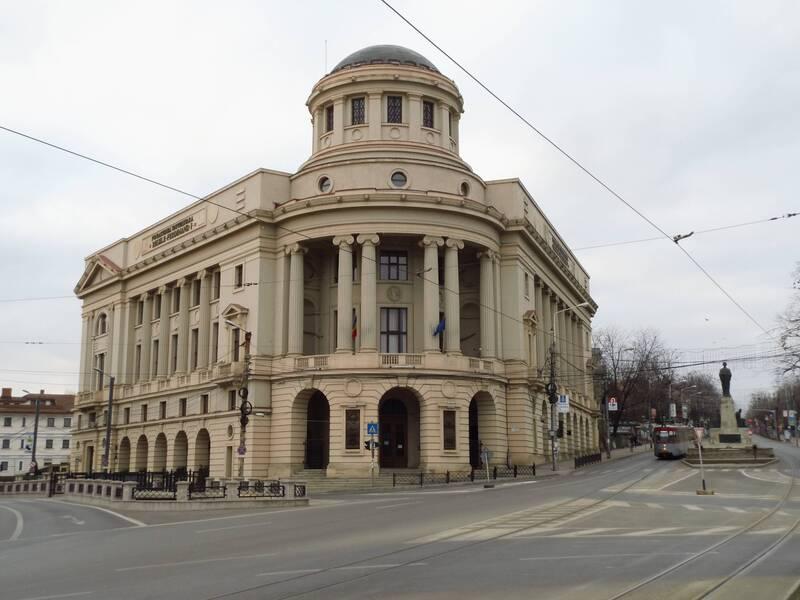
„Mihai Eminescu” Central University Library of Iași (photo: Jon jery, CC BY-SA 4.0)
The university libraries work either within state or private universities. After 1989 their number is quite variable given the foundation and later abolition of some private universities, or the absorption of some state universities.
The special libraries are financed by authorities, institutions or other legal persons, either public or private, they are subordinated to. Given the diversity of institutions they work with, the network of special libraries is the most heterogeneous and least known, their representatives being quite rarely members of library associations or participating in professional or scientific activities. After 1989, many of the special libraries just disappeared because of the abolition of the institutions they belonged to: industrial enterprises, culture houses, trade unions etc. At the moment, the network of special libraries include libraries subordinated to central public administration authorities (Government, Presidency, Parliament, the High Court of Justice etc.), national research and development institutes, the research institutes of the Romanian Academy, museums, media institutions like the Romanian Television or the Romanian Broadcasting Society and so on. Among them there are some quite important ones to mention, having a great tradition, for example the Library of the Brukenthal National Museum in Sibiu (founded at the end of the 18th century), the National Military Library (founded in 1860 and holding the right to legal deposit for documents in the military field issued by natural or legal persons outside the military forces), the Library of the Holy Synod of the Romanian Orthodox Church (founded in 1887) or the Library of the Chamber of Deputies (founded in 1918).
The network of public libraries includes the Metropolitan Library of Bucharest, the county libraries, the municipal and town libraries and the village libraries. The Metropolitan Library and the 40 county libraries hold the right to legal deposit for documents published on the territory of Bucharest and all over the relevant counties, respectively, based on which they elaborate and publish the current local bibliographies. At the same time, they coordinate the activities of the public libraries throughout the relevant county.
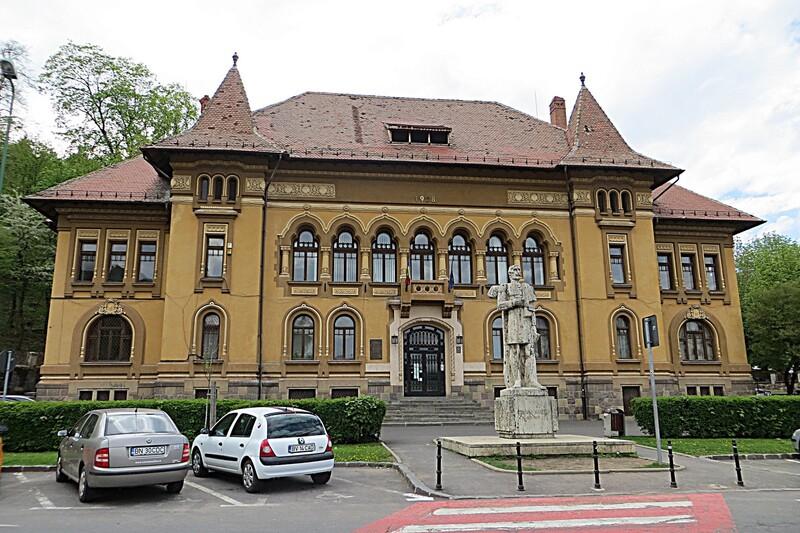
County Library of Brasov (photo: Mister No, CC BY 3.0)
The category of school libraries includes libraries of the teachers’ houses, accomplishing roles of information and documentation for the teaching personnel in pre-university education institutions. They are subordinated either to each county’s school inspectorate or to the municipal school inspectorate of Bucharest. Before 2013, when it was closed and included in the structure of BCU “Carol I”, the school library network was coordinated by “I. C. Petrescu” National Pedagogical Library. At the moment, the methodological guidance of the libraries of teachers’ houses and of the school libraries in Bucharest and all over the country is in charge of the Section of Professional and Methodological Assistance for Pre-University Education of the Research and Methodology Department of BCU “Carol I”.
After the year 2000, a new information and documentation structure appeared in the primary education system: the documentation and information centres (CDIs), taken over from the French education system and hence a new job was created: the teacher-librarian. The CDI was first introduced as an information-documentation structure meant for rural communities. Yet later, by force of the Romanian-French bilateral project for the promotion of rural documentation centres and for teaching staff training, developed by the Ministry of Education in collaboration with the Cooperation and Cultural Action Service within the Embassy of France in Bucharest (2000–2006) and the national project Education Through Information (2006–2009), CDIs have been established in preschool, school and high-school institutions. The CDIs were aimed at ensuring free access to information, documentation and culture, in structures that improve the learning and teaching conditions in the pre-university education institutions, making the learning process more attractive and bringing it closer to the European models.
The activity of institutions in the National Library System that are financed from public funds is coordinated by the National Library Commission, a scientific authority coordinated by the Ministry of Education and the Ministry of Culture. The National Library Commission was established after the issuing of the Library Law, was active between 2002 and 2009 and, after a break, recently resumed its activity (September 2018). It has 23 members, appointed for a period of three years, representing all categories of libraries, professional associations and authorities of central public administration in charge with libraries. Among the Commission’s attributions the following can be mentioned: elaboration of programs, methodologies and strategies, elaboration of selection and promotion criteria for the staff, of norms for the organization and functioning of libraries and of the yearly report regarding the situation of the National Library System.
2.2 The National Library of Romania
The National Library of Romania was established in 1955, under the name of Central State Library, as the main public library in the country, on the basis of modern principles of library and information science and with the functions and responsibilities of a national library, according to the UNESCO standards. In January 1990, the Central State Library became the National Library of Romania.
Meant to preserve the country’s cultural memory, the National Library of Romania, an institution subordinated to the Ministry of Culture and National Identity, contributes to building a modern, dynamic and well-educated society, to opening pathways to the national and universal culture and spirituality, takes an active part in the social, cultural and economic development of the country and provides access to its collections for information, study and research purposes to the present and future generations.
The National Library of Romania has the following functions and responsibilities among others:
-
it collects, processes and preserves all types of documents belonging to the national heritage including printed publications (books, periodicals), manuscripts, old books, incunabula, maps, photos, audio-visual documents and electronic documents;
-
it organizes and manages the National Reserve of Publications;
-
it searches, identifies and completes its own collections with publications going to be included in the special category called Românica (works published in any country and in any language, referring to the Romanian culture and civilization);
-
it elaborates the National Bibliography of Romania for all types of documents;
-
it coordinates the project of the National Joint Catalogue of the Romanian and Foreign Publications and the National Shared Catalogue and, at the same time, it initiates other projects of national interest in the field;
-
it coordinates the National Virtual Library, as part of the European Digital Library;
-
it coordinates and creates the National Authority Files, as uniform access points to information.
The National Library of Romania has also the following attributes derived from its status of National Bibliographic Agency:
-
it manages and coordinates the legal deposit at a central level as National Agency for Legal Deposit;
-
it is the national ISBN-ISSN-CIP Centre;
-
it is the National Methodology Centre, elaborating instructions and norms for the public libraries; it draws up studies, researches documentary information in the field of librarianship, as well as in other fields of cultural interest;
-
It is the National Centre of Document Pathology and Restoration.
2.2.1 The library’s new headquarters
The new headquarters of the National Library was inaugurated on April 23rd, 2012, after a waiting period of more than 50 years. The construction work began in the 1980s, but it was stopped after the Revolution in December 1989. In the 1990s, the Government allocated financial resources exclusively for the conservation of the site. The design of the building was intended to provide numerous open areas for reading offering free Internet access, spaces for exhibitions, conferences, performances and socializing, aiming to define and connect the “covered street“-type areas and the “classical” library ones.
Having an overall built area of 112,000 square meters, the new headquarters of the National Library is the third largest building in Romania, after the People’s House (Romanian Parliament) and House of the Romanian Academy. The building contains two sections ‒ the library section (ten levels) and the auditorium section (eight levels).
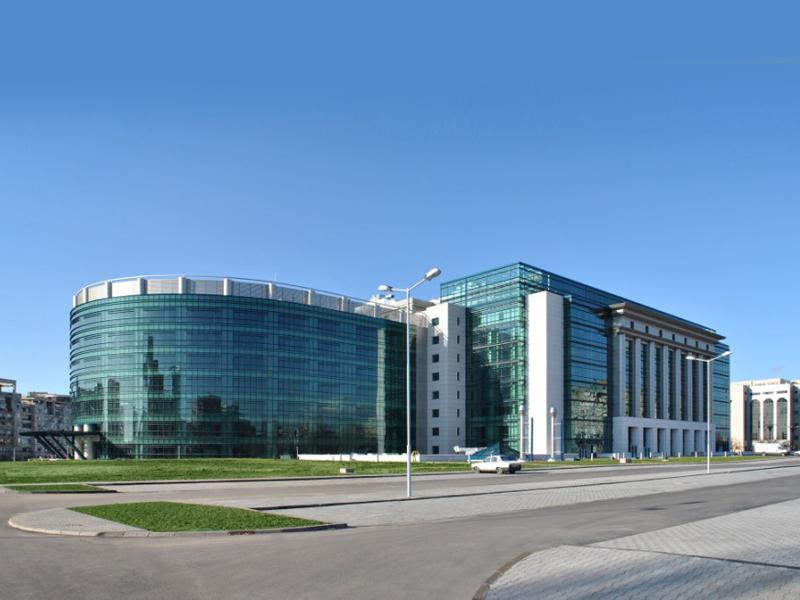
National Library of Romania (photo: Madalina Lefter, librarian, National Library of Romania – personal collection)
The library has sixteen reading rooms, nine of which are currently open to the public.
The library offers modern rooms fully equipped for the study and continuing education in library science offering research possibilities for bibliophile books, book pathology, book preservation and restoration etc.
The open areas located on the ground floor and mezzanine (about 6,000 square meters) have been designed as a free reading and socializing area where everyone can enjoy privacy in reading, while being surrounded by others. The combination and harmonious integration of different area modules for reading, discussions and workshops, for cultural purposes and for exhibitions creates a dynamic, friendly and reflective atmosphere.
The library has four modern, effectively equipped conference rooms. The “core” of the library – the atrium multipurpose space (800 square meters) on the ground floor and the library section – are 30 meters high and have the advantage of natural daylight: a large skylight, flanked by four small skylights.
2.2.2 Collections and facilities
The National Library’s collections include approximately 12,500,000 bibliographic units of encyclopedic profile divided into current collections (books, periodicals, records, CDs, DVDs, audio and video cassettes, eBooks etc.) and special collections (old and rare books, manuscripts, correspondence, historical archives, early periodicals, prints, photographs, old maps, printed music, gramophone records etc.).
The Special Collections are treated in seven departments: Bibliophile Documents, Manuscripts, Photographs, Historical Archive, Engravings/Prints, Audio-Video Documents, Cartography and are situated on the fifth floor, in the library section. The number of bibliographic units in these collections is 350,000.
The library offers free reading access. The users need a library card to get access to the library collections. The free access to the Internet is granted, both in the free reading areas and in the reading rooms. The National Library facilitates the access of blind or visually impaired users to information and also provides appropriate conditions for the access of people with movement disorders in the building.
2.2.3 Branches of the National Library of Romania
The Batthyaneum Library in Alba Iulia has been a branch of the National Library of Romania since 1962. It was founded on July 31st, 1798 at the initiative of the Roman Catholic bishop of Transylvania, Batthyány Ignác (1741–1798). Today’s fundamental treasure of the Batthyaneum Library is the private collection of Bishop Batthyány Ignác, consisting of 18,000 bibliographic units, prints and manuscripts dating as far back as the 9th century. Some of the documents come from the collections of Cristoforo Migazzi, the Archbishop of Vienna, and from St. Jacob Church in Levoča.
Among the 115,992 bibliographic units held in the collections of the Batthyaneum we can mention:
-
1,778 manuscripts (the oldest dating from the 9th century), of which 300 are Western medieval codices (80% of the total existing in Romania);
-
571 incunabula (70% of the total existing in Romania);
-
24,000 books published in the West of Europe between the 15th and 18th centuries;
-
17,163 documents that come from the Archive of the Roman Catholic Church from Alba Iulia and from the Convent of Cluj-Mănăştur, representing diplomatic sources for the medieval history of Transylvania;
-
43,081 manuscript letters of Transylvanian personalities dating from the 18th to the 20th century.
There is also an archaeological museum inside the library, whose collections include prehistoric and ancient museum objects, coins (from classical Greece, Rome and also from Ancient Dacia), seals, medals, ornaments, pendants, banknotes, minerals (stones, gems, crystals), shells (208 species), astronomical instruments, clocks, religious art objects specific to the Roman Catholic Church, liturgical vessels, paintings, ex-libris labels, plans and maps.
The Omnia library in Craiova was founded at the initiative of a group of intellectuals from Craiova – writers, theatre people, academics, artists – with the support of the Institute for the Development of Cultural Relations with Romania from Lyon, France, and with the help from the municipality’s office and the citizens of Lyon. On May 25, 1990 the Omnia Library became a branch of the National Library of Romania. The official opening of the library took place on July 1st, 1991, in the presence of prominent guests, personalities belonging to the cultural and political life of Craiova and of the country in general and many delegates from France, led by the Mayor of Lyon.
The Omnia Library holds a stock of about 30,000 volumes from a large variety of disciplines: fiction, literary history and criticism, linguistics, history, sociology, medicine, philosophy, art, sports, geography, management and marketing, economics. Reference materials such as encyclopedias and dictionaries, as well as a large collection of periodicals can also be found in the library.
The Omnia Branch Library is housed in a stately building, a monument of architecture, known as the Plesia House. It is mentioned in the Historical Monuments List, being one of Craiova’s remarkable buildings, built in 1890 according to the design of the French architect Albert Galleron. It was built in eclectic style with neoclassical predomination in the inside, having stained glass windows made in the spirit of the Romanian school, with geometric and floral themes. The interior staircase and baroque style ironwork, the gold-plated ceilings, the Venetian mirrors and sculpted paneling make it a place where you want to remain.
2.3 Legislation regarding libraries
After 1989, the Romanian legal system in its entirety has undergone important changes in order to respond to the challenges of a democratic society. This was also the case of the legislative issues regarding libraries. In drawing up the library legislation, an important contribution, by means of the special advice they gave or by the points of view they expressed, belonged to the library associations and also to the representative institutions within the National Library System.
In 1995 Law no. 111 regarding the legal deposit was adopted (modified in 2007), stipulating that the legal deposit is organized on a central level by the National Library of Romania. On a local level, the legal deposit on which the local bibliographies are based, is organized by the county libraries and by the Metropolitan Library of Bucharest. The number of copies preserved for the legal deposit varies between one and seven, according to the document type.
The Education Law no. 84/1995 (today repealed) dedicated a separate chapter to the education libraries. The law provided for the creation of a specialized advisory body belonging to the Ministry of Education – the National Council of Education Libraries (CNBI), having multiple duties. Among them we can mention the duty to establish the development strategy of school and university libraries, to participate in drawing up the projects of regulatory acts concerning libraries, to formulate recommendations regarding the assurance of material and financial resources necessary to the education libraries and so on. CNBI was established in early 1998 and was active for eight years (1998–2006).
By force of Law no. 128/1997 regarding the status of teaching staff, the education librarians were recognized the status of auxiliary teaching staff. The law imposed certain mandatory professional skills as conditions for those who aimed at holding positions in school and university libraries, for example graduating from library studies or from other schools whose curriculum includes some library-oriented disciplines – in case of open-ended employment – or the attendance of introductory courses in library science for fixed-term employment. These provisions were regarded as an absolute novelty for the Romanian libraries. Although Law no. 128/1997 was repealed, some of its provisions can still be found in the Library Law and, to a smaller scale, in the Education Law which has been in force since 2011.
Law no. 128/2000 regarding the protection of the national mobile cultural heritage establishes the judicial status of the valuable documents held by libraries and regulates the specific activities dedicated to their protection. This law divides the national mobile cultural heritage in two categories: assets which belong to the treasure (“cultural assets of exceptional value for the humanity”) and assets which belong to the stock (“cultural assets of exceptional value for Romania”). Manuscripts, incunabula, rare books, both old and having a bibliophile value, archive documents, maps and other cartographic materials are included in the category of archeological and historical documentary assets which constitute the national mobile cultural heritage. The classification of assets in the national mobile cultural heritage is decided by the National Committee of Museums and Collections, and the libraries, together with all other public institutions which hold mobile cultural assets, are obliged to keep their inventory and preserve them.
The Library Law no. 334/2002 can be considered the greatest achievement of the library profession after 1989, because it places in a unitary framework the provisions of a great number of former regulations and norms concerning libraries and introduces some new ones. The law defines the National Library System (consisting of “the total number of libraries governed by public law and libraries governed by private law which have activities specific to those governed by public law”) and regulates the specificities and attributions of the five categories of institutions which are included in it: national libraries, university libraries, special libraries, public libraries and school libraries. The law also contains some chapters regarding the heritage, the personnel and the administrative board of libraries, the National Library Commission, the rights and duties of the library users as well as an annex including requirements for the employment of the specialized personnel.
The law regulates the functioning of two libraries having the status of national libraries in our country – the National Library of Romania and the Romanian Academy Library. It also reconfirms the status of the central university libraries as institutions of national importance in the field, having as attribution the granting of methodological and professional assistance to other university libraries in the geographic area they activate. The role of methodological coordination granted to the libraries of the teachers’ houses and to the school libraries was played by “I. C. Petrescu” National Pedagogical Library (which is today a section of “Carol I” Central University Library of Bucharest).
On the whole, Law no. 334/2002, which was modified several times over the years, had beneficial effects, even though some of its provisions were very difficult or even impossible to be applied, because of lack of correlation with the provisions of other laws, or simply because they were not respected by the responsible authorities of the libraries, mostly invoking financial resource problems.
The acquisition of new publications was and still is one of the most critical problems of Romanian libraries, because of financial shortage. Law no. 186/2003 regarding the promotion of written culture was intended to contribute to resolving this problem, by stipulating the obligation of the Ministry of Culture and the Ministry of Education, as much as the local administration authorities, to include in their own budgets separate funds dedicated to the acquisition of publications for the public and school libraries.
The new law of education – Law no. 1/2011 – has reconfirmed the status of auxiliary teaching staff of the specialized personnel employed in the education libraries and their obligation to attend specialized studies in the library field. Except for this regulation and a few others taken over from previous legislative acts, this law contains a few new provisions regarding libraries. It confirms the functioning of two types of info-documentary structures in the pre-university education – the school library and the centre of documentation and information, which are organized and work according to the regulation drawn up by the Ministry of Education.
The Romanian legislation has included and includes provisions which could contribute to the development of libraries. However, more than once, the law articles which involve an extra budgetary effort are not applied or they are partly applied, the authorities invoking, more or less legitimately, the lack of financial resources. In other cases, the law is not respected because of the indifference of some responsible authorities, at all levels, with regard to the situation of libraries.
2.4 Professional education
After the 1989 Revolution, the initiation of the Romanian higher education in library science is connected with the Faculty of Letters at the University of Bucharest. Its activity started in the academic year 1990–1991 and the department is still active now, organizing library and information science programs. According to the Bologna Process and the European Higher Education Area implemented also by Romania’s higher education system, since 2005 the Faculty of Letters is organizing bachelor’s degree and master’s degree programs in Information and Documentation Sciences and Information Management in Contemporary Society. In addition, the specialized department provides postgraduate courses in Library and Information Science. The doctoral school of the Faculty of Letters at the University of Bucharest is the only one to have Ph.D. supervisors specialized in Library and Information Science in Romania.
Library studies at higher education level were organized in the not so distant past in other universities such as those in Braşov, Cluj-Napoca, Oradea, Sibiu, Suceava, Târgovişte or Timişoara. Some of these departments were unfortunately closed in the meantime for lack of candidates.
In Cluj-Napoca, the library education started in 1995. Currently, the Faculty of History and Philosophy at the University of Cluj gives bachelor degrees for studies in Information and Documentation Sciences and organizes postgraduate courses in Library and Information Science and training courses for teacher-librarians.
The Department of Library Science at the West University of Timişoara was established in 1999 at the Faculty of Letters, History and Theology. At present, undergraduate studies are organized by the Faculty of Political Sciences, Philosophy and Communication Sciences and they include specialized courses in Information and Documentation Sciences.
Beginning with the academic year 1991–1992, “Lucian Blaga” University in Sibiu is organizing three-year college studies in Library Science and Archives. Currently, the Information and Documentation Sciences Department gives a bachelor’s degree at the Faculty of Letters and organizes a master’s program for teacher-librarians.
At the same time with the Library and Information Studies organized by the main universities, the Romanian Library Association – and in particular the National Association of Librarians and Public Libraries in Romania – organize occasionally, whenever necessary, a number of post-secondary courses for librarians holding a secondary degree, who do not have such specialized training, and for high school graduates wishing for a library career.
According to the Library Law, the continuing education courses can be organized by different kinds of institutions, which include library associations, big libraries, teachers’ houses, centres of continuing professional education belonging to the Ministry of Culture and the Ministry of Education and by other organizations duly authorized for this purpose.
2.5 Library associations
The first library associations in Romania were established in the inter-bellum period. Despite some audacious objectives and the participation of a number of cultural and professional personalities in them, their activity was rather unassertive. In 1919, the Association of Public Libraries was established with the declared purpose “to contribute to the reconstruction of the libraries destroyed by the war and help the building of new libraries”. This was followed by the Romanian Library Association in 1924, initiated as an exclusive association, with high objectives such as “finding solutions to all the problems of libraries and librarians”.
In the communist period, the impediments against all forms of association which could get them outside their control, made the normal functioning parameters of such professional associations almost impossible.
Under these circumstances, immediately after 1989, one of the foremost preoccupations of librarians was their coming together on professional criteria. After the isolation specific to the communist era, the associations were offering the librarians the necessary framework for cooperation, for professional development and for communication with professionals from other countries. The initiators of the association procedures, however, had a different option but the creation of a single professional organization. Their choice was to establish one for the librarians in educational institutions – the Association of Librarians in Education – Romania (today’s Romanian Library Association, ABR) and another one for the librarians in public libraries – the Association of Librarians in the Romanian Public Libraries (today’s National Association of Librarians and Public Libraries in Romania, ANBPR). These are and keep being the most important library associations in Romania from the number of members’ and geographic coverage perspectives and considering the diversity of their activities, both at national and international level, from their creation in 1990 until today. ABR and ANBPR are both members of IFLA and EBLIDA.
Later on, from the association of public libraries two different associations were derived: the Association of Romanian Librarians and Documentarists, belonging to the Metropolitan Library (having no activity as of today) and the Association of Librarians in the National Library of Romania.
A fifth association, i.e. the Association of Hungarian Librarians of Romania, was clearly based on ethnic criteria, bringing together the Hungarian librarians from all types of libraries.
The Romanian Library Association is organizing national conferences each year (the 30th conference took place in 2019) and has an important and consistent publishing activity. This is proved by the publication of numerous books and by the editing of one of the most prestigious Romanian journal in the field – Romanian Journal of Library and Information Science. ABR is organized according to the IFLA model, in divisions (national libraries, university and specialized libraries, school libraries and public libraries) and professional sections dedicated to special topics such as acquisitions and collection development, cataloguing – classification – indexing, information literacy, library legislation and professional development, statistics and evaluation, library automation and so on.
Over the years, ABR has been the organizer of conferences, seminars, professional instruction courses both alone and in cooperation with national administrative authorities and foreign cultural bodies in Romania such as Goethe Institute, the French Cultural Institute, the British Council and the Cultural Service of the US Embassy. Furthermore, ABR has connections with professional organizations from other countries among which are the Norwegian Library Association, the Belgium Library Association, the European Bureau of Library Information and Documentation Associations (EBLIDA) or the International Federation of Library Associations and Institutions (IFLA). ABR recently contributed to the organization of the first IFLA satellite conference in Romania, Libraries and the 2030 Agenda: Prospective Information and Forthcoming Society (Timişoara, 2017), and also to the conference entitled Multicultural Information Services: Supporting Identity and Diversity (Timişoara, 2018), with the participation of members of IFLA Standing Committee – Section 32: Library Services to Multicultural Populations (IFLA MCULTP).
The National Association of Librarians and Public Libraries in Romania is organizing national conferences each year and provides introductory and advanced courses in library science. ANBPR has participated in the achievement of some projects meant to sustain the development of public libraries. We can mention here the National Automation and Service Development Program in Romanian Public Libraries and the National Program of Romanian Performances in Public Libraries – PROBIB 2000. The most important projects in which ANBPR had an important contribution have been carried out within the Biblionet Program, sponsored by Bill & Melinda Gates Foundation, by which a sum of 26.9 million dollars has been invested in the upgrading of public libraries in our country. By this project libraries were equipped with new technology and librarians were trained to provide ICT-based services, which turned most of the public libraries throughout Romania into digital hubs for local communities. Through Biblionet, over 80% of Romania’s libraries were equipped with high-tech tools and Internet connectivity, reaching over 600,000 first-time Internet users and 4,200 librarians were trained to use new technology to provide better services to library visitors and their communities. ANBPR was professionalized, from its ability to serve its members to its capacity to cultivate partnerships with private and public actors, and the government support for libraries at local and national levels was expanded.
2.6 Library science publications
After 1989, due to the change of political regime, access to updated information in the library field became far easier. The number of subscriptions to journals and the acquisition of specialized books from countries with a significant library tradition such as the USA, Great Britain or France has grown. From the second half of the nineties on, access to online electronic resources available on the internet and to scientific databases was added to those. The reorganization of library higher education was stimulating the publication of primer courses and manuals reflecting the novelties in the field. It appeared a new generation of professionals, interested in making themselves known also through theoretical approaches, which inspired the development of the Romanian literature dedicated to library and information science.
In this regard, the library associations had an important contribution by publishing a great number of both original works of Romanian authors and translated works in the field. The Romanian Library Association published to this day thirty works which include working tools, guide books, volumes dedicated to specialized terminology, anthologies of studies, documentary syntheses, translations etc. A special place among these is held by Tratatul de biblioteconomie [Treatise on librarianship], a work wide-ranging in scope, published in three volumes (2012–2017) and authored by more than thirty Romanian and foreign professionals. At the same time, under the auspices of the association, a book entitled Romanian Libraries (2011) was published in English, being the first work dedicated by Romanian library professionals to foreign readers in which the Romanian libraries are presented in a synthesis.
In their turn, the National Association of Librarians and Public Libraries of Romania published manuals, guide books, university textbooks and translations of some outstanding works such as Library performance indicators and library management tools (Suzanne Ward, David Fuegi, John Sumsion, Ian Bloor, 1997).
Biblioteca Bucurestilor Publishing House, whose activity was carried out under the auspices of the Metropolitan Library and the Association of Librarians and Documentalists in Romania, awarded an exclusive attention to translations, publishing translated works like Accueillir, orienter, informer (Bertrand Calenge, 1999).
Books on library science were also printed by publishers of the higher education institutions that organized, or are still organizing, library studies, such as the publishing houses of the University of Bucharest, “Babeş-Bolyai” University of Cluj, West University of Timişoara or “Transilvania” University of Braşov.
The serial publications dedicated to the field of library and information science have also known an important progress after 1990. The best known, most circulated and long lasting professional journal, Biblioteca [The Library], has just celebrated its 70th anniversary in 2018. It kept on its monthly appearance, the National Library of Romania being responsible for its publication today. The main mission of the journal is to popularize, to inform readers about the library activities in the country and highlight the trends in Romanian and international librarianship. Biblioteca publishes informative articles, interviews, surveys, book reviews, studies approaching subjects of interest for a wide range of readers, from all types of libraries.
Since 1997, the Romanian Library Association is issuing quarterly the Romanian Journal of Library and Information Science (RRBSI). RRBSI is the Romanian journal with the strongest library-oriented content. Between 2010 and 2016, the journal articles were published simultaneously in Romanian and English, in an attempt to expand their dissemination internationally. Now, under the title of Revista Română de Biblioteconomie şi Ştiinţa Informării = Romanian Journal of Library and Information Science, this is an open access journal published exclusively in English. RRBSI aims to publish original contributions to all aspects of library and information science: research articles, new outlooks and opinions, commentaries and book reviews. Given the similarities in the history and development of libraries in Central and Southeastern Europe, the journal is focused on publishing studies on theoretical and practical library issues in the countries in this region. However, this approach is not exclusive, other themes being also covered. The entire archive of RRBSI is available on the journal’s site. The contents of the journal is available too, entirely or partly, in international databases which include Central and Eastern European Online Library (CEEOL), EBSCO Library and Information Science Source, or Directory of Open Access Journals (DOAJ).
Studii de Biblioteconomie şi Ştiinţa Informării = Library and Information Science Research is a scientific journal edited by the Department of Information and Documentation of the Faculty of Letters at the University of Bucharest. The journal was first issued in 1995 and contains original articles regarding theoretical and practical aspects in library and information science, book reviews, reports on professional and scientific meetings, presentations of research projects etc. The articles are published in parallel in Romanian and English. Since 2018 it has been published as Information and Communication Sciences Research. The Journal is indexed in international databases such as EBSCO Library, Information Science & Technology Abstracts with Full Text, ProQuest Library and Information Science Abstracts, CEEOL or DOAJ.
Biblos, a journal edited by “Mihai Eminescu” Central University Library and the Iași branch of the Romanian Library Association, was first issued in 1994 and publishes original articles on libraries and librarians, interviews, debates on professional subjects and translations from the international library-oriented literature. It is also available in electronic format.
Philobiblon – Transylvanian Journal of Multidisciplinary Research in Humanities, a biennial journal published by “Lucian Blaga” Central University Library” in collaboration with Presa Universitara Clujeana Publishing House, was started in 1996, in English. While in the first years of its life the library orientation was prevailing, over the years the journal acquired an ever growing multidisciplinary profile. The journal is indexed in prestigious international databases among which Scopus and Emerging Sources Citation Index can be mentioned.
Lecturn, a quarterly journal edited since 2013 by “Eugen Todoran” Central University Library in Timișoara, is a recent apparition in the landscape of Romanian professional publications. Here also, the articles related to specific subjects to the library and information science field are interconnected with contributions treating a large variety of cultural themes spinning around reading and libraries.
Apart from Biblioteca, the National Library of Romania is editing other important professional journals. Revista Bibliotecii Naţionale [National Library Journal], started in 1995, is dedicated to problems regarding the conservation, restoration and capitalization of their collections of documents, particularly those belonging to the cultural heritage, news from library field, but also subjects covering other fields like cultural anthropology and history of mentalities, arts, history, fiction, historiography etc. Revista Română de Istorie a Cărţii [Romanian Journal of Book History], first published in 2004, is issued annually as a result of the collaboration of the National Library with and “Carol I” Central University Library and the Romanian Academy. The publication brings together studies written by Romanian researchers focusing on the history of books, manuscripts, letters, ex-libris, photographs, maps, stamps, old periodicals, historical archives etc., as much as the reading practice.
Informare şi documentare: activitate ştiinţifică şi profesională [Information and Documentation: Scientific and Professional Activity], issued since 2007, is an annual journal offering the professionals in library and information science the space they need for publishing studies, research results and excerpts from master degree or doctorate dissertations.
There are other libraries, especially the county libraries, which have editorial activity, publishing journals whose content is dedicated to librarianship themes, to a smaller or larger extent.
All the articles, studies and specialized monographs published after 1990 demonstrate the concern of Romanian professionals to stay connected to the current themes of library and information science and, at the same time, to bring their contribution to the evolution of the field’s theoretical approach.
3 Trends
3.1 Current library statistics
The graphs below give an account on the number of libraries and on the usage and activities of Romanian library services in 2016 and 2017.
According to the data supplied by the National Institute of Statistics, the Romanian library network included between 2016–2017 approximately ten thousand administrative units and 103 branch libraries (Figure 1). Mention should be made that the National Institute of Statistics includes the National Military Library in the category of national libraries in its reports, although this is disagreeing with the classification specified by the Library Law.
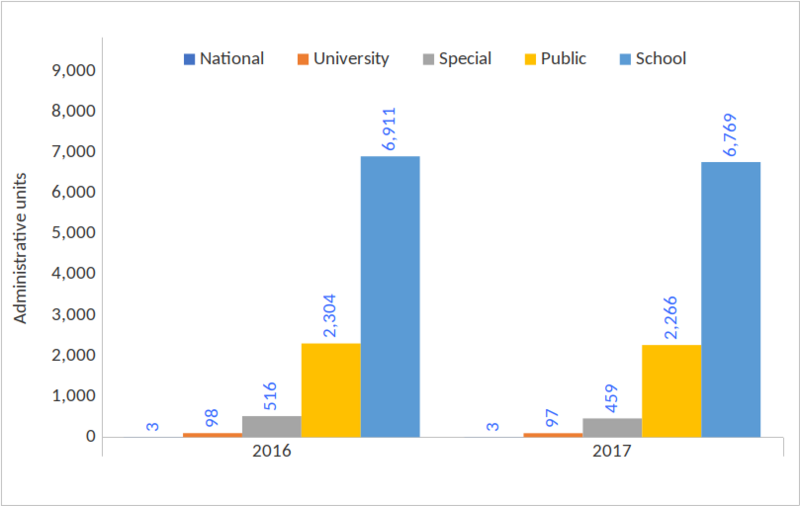
Figure 1. Romanian library network
In 2017, libraries had in their collections over 163 million volumes, one million fewer volumes than in 2016. There were 3,520 libraries working in urban areas (compared with 3,581 in 2016) plus 97 branch libraries, holding a stock of 124.7 million volumes (three quarters of the national book stock available in libraries). In the rural areas, although the number of libraries is considerably bigger, i.e. 6,074 libraries in 2017 compared with 6,251 in 2016, with only six branches, the stock of publications is much smaller, i.e. less than 40 million volumes (Figure 2).
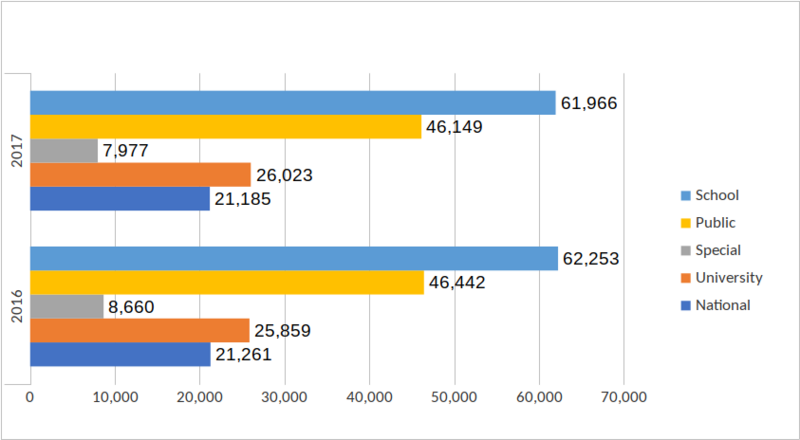
Figure 2. Number of volumes held by Romanian library collections (thousands of volumes)
The number of active users was a bit bigger than 3.2 million in 2017, still going down from over 3.4 million as of 2016. The distribution of the number of active users shows a dominance of school library users (50.6%) and public library users (38.1%) over other categories (Figures 3, 4).
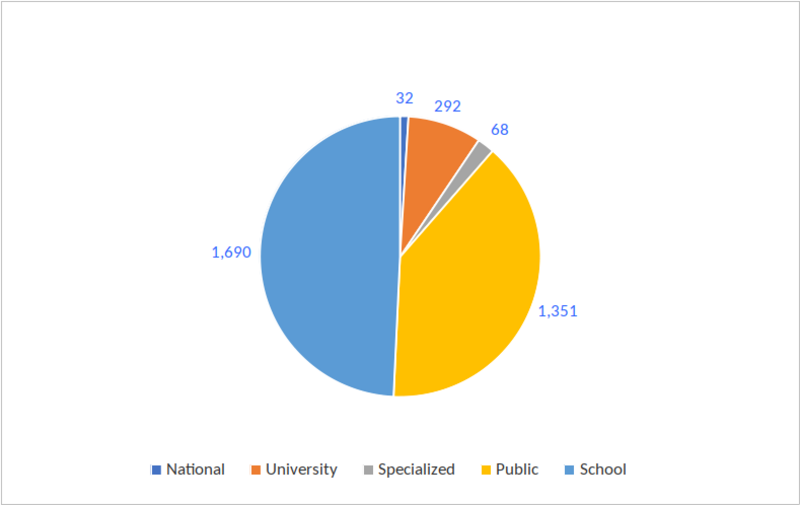 Figure 3. Active users in 2017 (thousands of users)
Figure 3. Active users in 2017 (thousands of users)
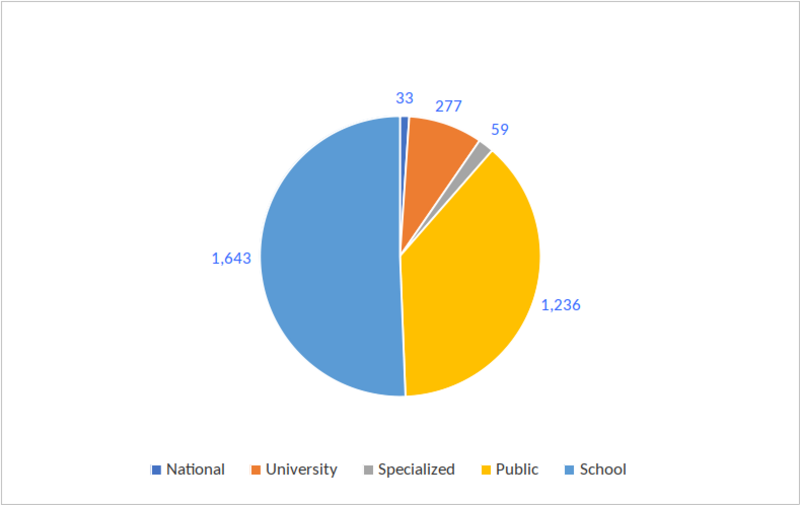 Figure 4. Active users in 2016 (thousands of users)
Figure 4. Active users in 2016 (thousands of users)
The number of volumes circulated by different categories of users was in 2017 amounting at 35.8 million (compared with 38.2 million volumes in 2016), meaning an average of 11 volumes per user, similar to the previous year (Figure 5).
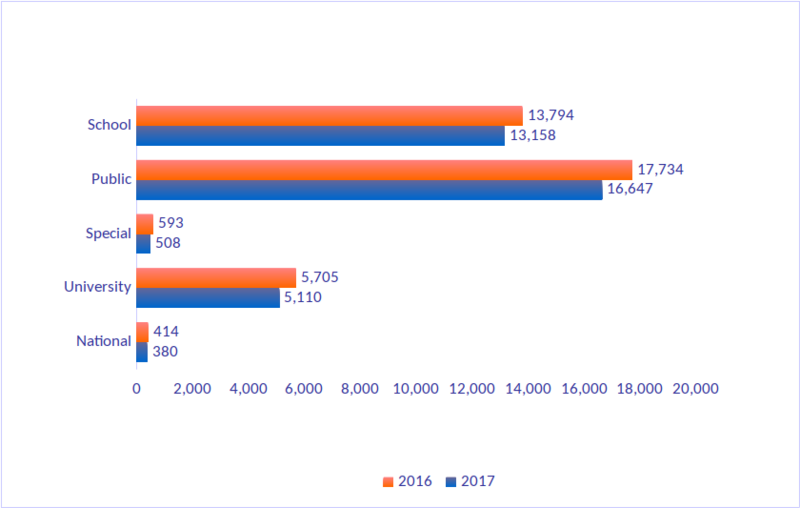
Figure 5. Volumes circulated in Romanian libraries (thousands of volumes)
Accessible to the public at large throughout the country, the network of public libraries including county, municipal, city and village libraries provided the users with 46 million volumes of printed books and periodicals, 29.2 million of printed books and 37 thousand of e-books.
Related to the size of population, in 2017 a public library served an average of 8.7 thousand inhabitants (8.6 thousand in 2016). That means an average of 2.3 volumes from the collections of public libraries per person, the services of these libraries being offered to 1.2 million of active users. For the population that used the public library services, an average of 37 volumes per user were available in 2017 (Figure 6), whereas in 2016 this number was 34 volumes per user (Figure 7).
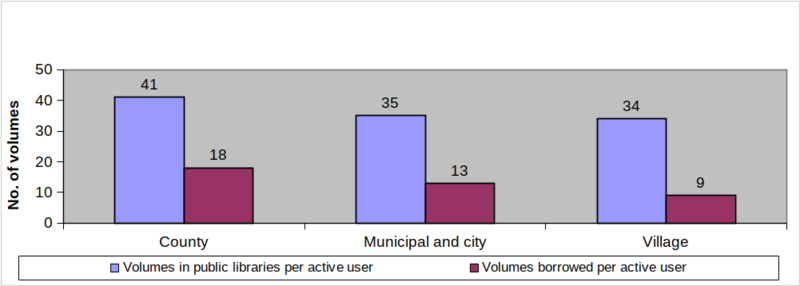
Figure 6. The main performance indicators recorded by public libraries (per library type) in 2017
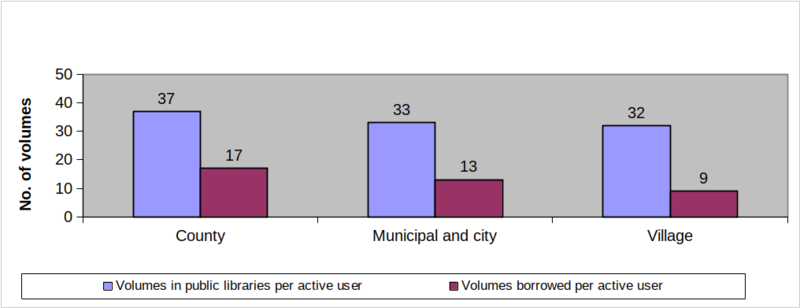
Figure 7. The main performance indicators recorded by public libraries (per library type) in 2016
The library personnel consists of three separate categories: specialized personnel (librarians, bibliographers, book restorers, preservers, computer specialists and others), administrative personnel and maintenance personnel. At the end of 2017, the personnel in all types of libraries comprised 10,592 people, of which 91.3% were specialized personnel; at the end of 2016, it comprised 10,844 people, of which 91.5% were specialized personnel (Figure 8).
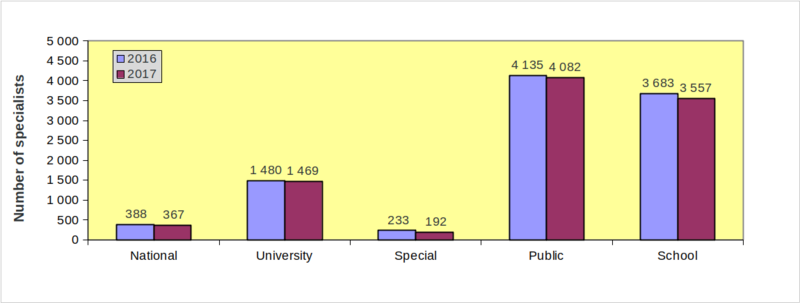
Figure 8. Distribution of specialized personnel per library category (number of employees)
3.2 New library buildings
After 1989, building new libraries capable to answer such requirements as the need for extension space devoted to collection development and, at the same time, to agree entirely with the changes in the information environment and the effect of those changes on the users’ behavior, on their expectations from the library space, were considered as no priority for the Romanian financing entities. However, there are some examples of significant investments in building such structures, either dedicated to the expansion of old library headquarters or for some new ones, in which they moved all their collections and organized all their activities.
In the first place, mention should be made on the completion of the new headquarters of the National Library of Romania (2012), on whose construction, started in the communist time, we have given details earlier in the section dedicated to this institution.
“Carol I” Central University Library of Bucharest, whose building was burned down along with over 500,000 volumes during the December 1989 Revolution, stirred such a public emotion and generated a huge media campaign for the disaster it had underwent, that it was considered an essential investment objective. The building project concerning the library was intended not only to restore the old building (finished only in 2011), but also to extend the existing one by a new wing. This wing, known under the name of “Boema”, has an area over 10,000 square meters and was open to the public in 2001. Being mainly designed for the users, it provides 385 seats in seven reading rooms, ten individual study rooms, large spaces for collection storage and an exhibition area.
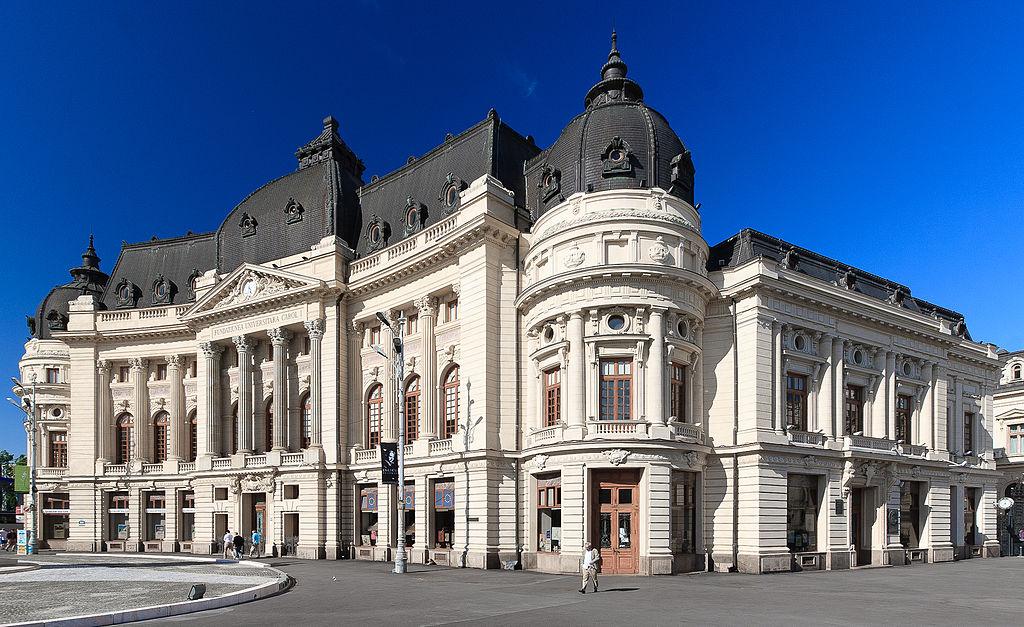 „Carol I” Central University Library of Bucharest (photo: Alexandru Ene, CC BY-SA 3.0 ro)
„Carol I” Central University Library of Bucharest (photo: Alexandru Ene, CC BY-SA 3.0 ro)
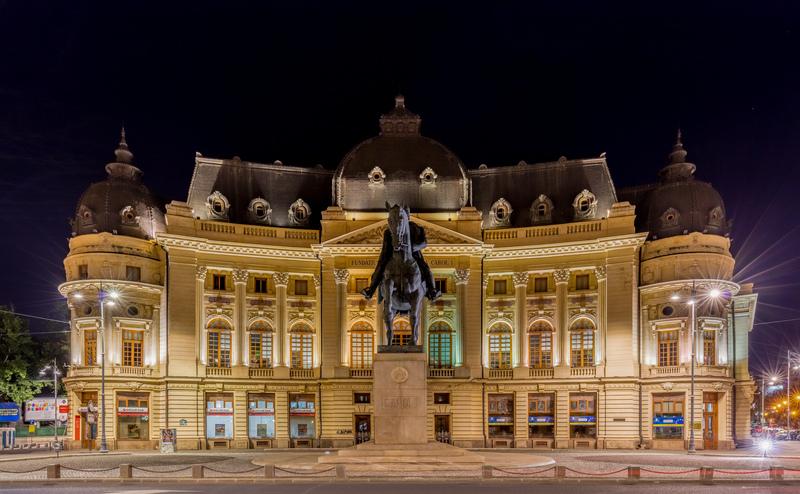
„Carol I” Central University Library of Bucharest (photo: Diego Delso, CC BY-SA 4.0)
The Romanian Academy Library also benefits of an extension of about 16,000 square meters including reading rooms, stores, a conference room and an exhibition room since 2001.
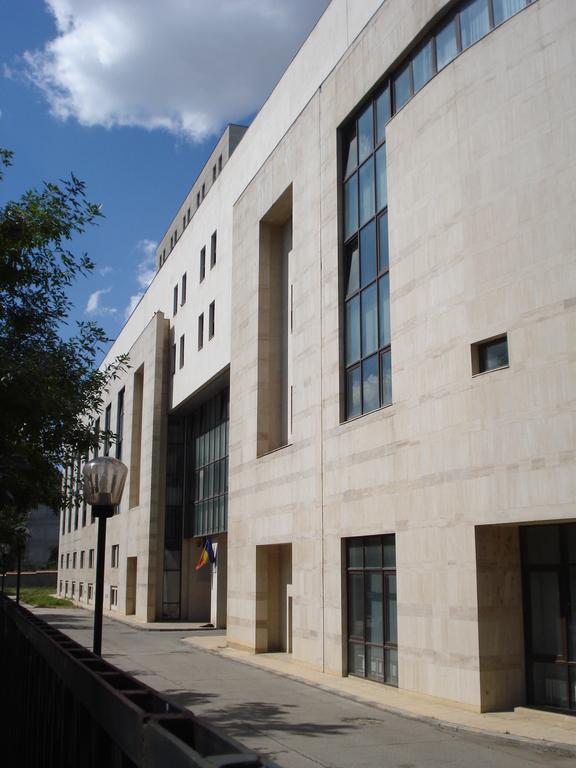
Library of the Romanian Academy – new building (photo: Pixi, CC BY 2.5)
New buildings or additional spaces to the old ones have been allocated to a number of county libraries (from Argeș, Brăila, Cluj, Maramureş, Sibiu, Vâlcea), municipal libraries (like “Ștefan Luchian” Municipal Library in Moinești or “Radu Rosetti” Municipal Library in Onești) and many university libraries (like the central university libraries in Bucharest, Cluj-Napoca and Timişoara plus the Library of “Transilvania” University in Brașov, Library of “Lucian Blaga” University in Sibiu, the Library of “Iuliu Haţieganu” University of Medicine and Pharmacy and the Library of the University of Agronomy Sciences and Veterinary Medicine in Cluj-Napoca, the University Library in Oradea, “Politehnica” University Library in Bucharest or the similar one in Timișoara).
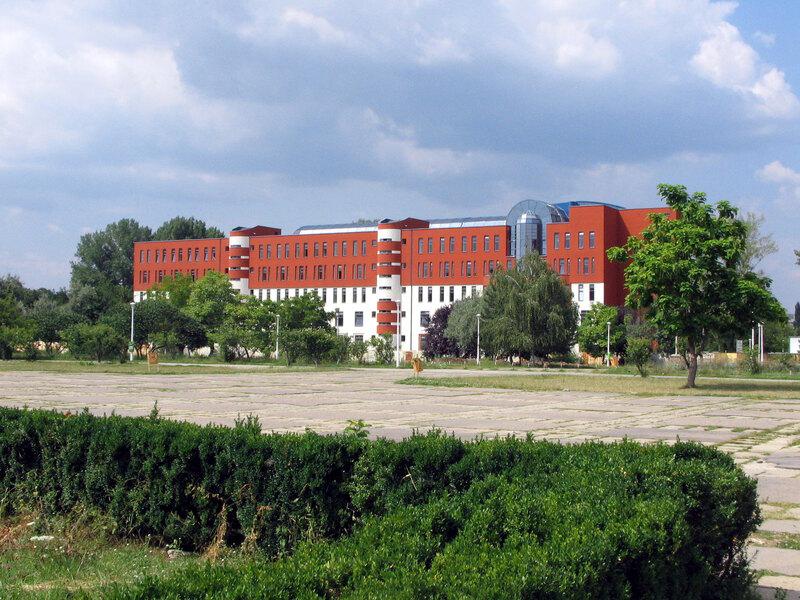
Central Library of „Politehnica” University, Bucharest (photo: Andrei Stroe, CC BY 3.0)
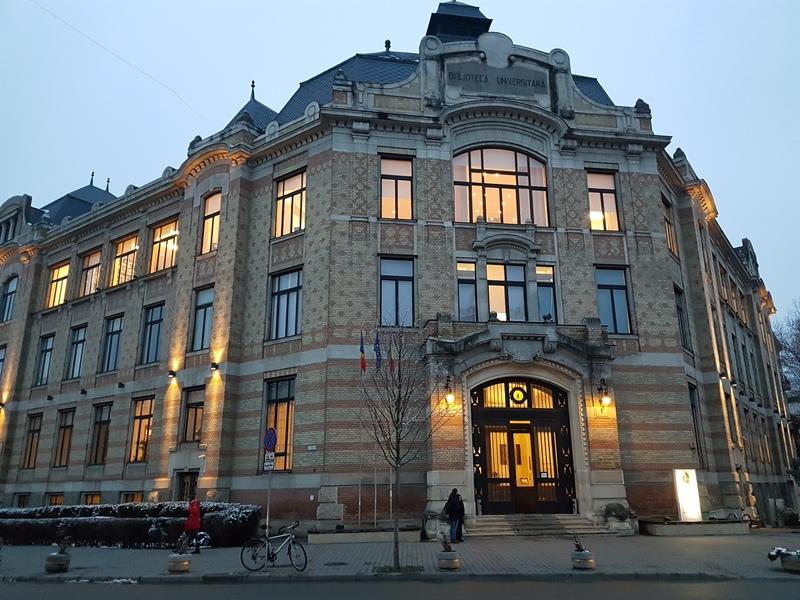
„Lucian Blaga” Central University Library of Cluj-Napoca (photo: Leontin I, CC BY-SA 4.0)
“Dinicu Golescu” Argeș County Library is working since 2003 in a new building of 4,900 square meters.
In the new building of “Octavian Goga” Cluj County Library, inaugurated in 2002, 85% of the collections are available in free access.
„Eugen Todoran” Central University Library in Timișoara has also a new wing since 2008. That is also the year when they have implemented the RFID system for the management of their collections.
The Library of “Iuliu Haţieganu” University of Medicine and Pharmacy in Cluj is housed since 2008 in a new building of the university, where it has possession of two floors and it holds five reading rooms with 245 seats.
The Library of Agronomy Sciences and Veterinary Medicine in Cluj has since 2015 its own new headquarters, with six floors and a total area of more than 5,000 square meters.
“Lucian Blaga” University Library in Sibiu has also a new building since 2009, with 400 seats for reading and study, six individual study rooms and a multimedia room for foreign language learning. A great part of the collection is available in free access. The library has implemented a self-checkout system based on RFID technology, where documents can be automatically checked out 24/7.
The new building of the University Library in Oradea was inaugurated in 2010 and has a total area of 7,650 square meters. It provides the users with five reading rooms and a total number of 520 seats in them.
In its new building, inaugurated in 2014, the Central Library of “Politehnica” University in Timișoara provides 650 study seats arranged in either closed, open or flexible spaces, many rooms for individual or group study, a study room open 24/7, an IT room having a capacity of 180 work stations, a multifunctional room provided with videoconference equipment (100 seats) and two auditoria holding 90 seats each.
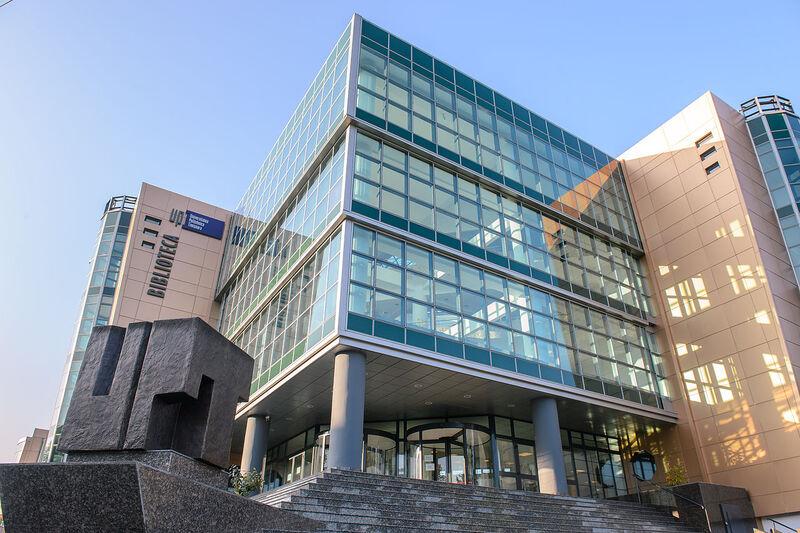
Central Library of „Politehnica” University, Timisoara (photo: Eugen.Stan.UPT, CC BY-SA 4.0)
3.3 Consortium acquisitions of electronic resources for university and research libraries
After the year 2000, important investments have been made for the acquisition of scientific electronic resources. Initially, only few of the university libraries with bigger budgets could afford subscriptions to individual databases produced by such publishers and aggregators like Springer, EBSCO, ProQuest and so on. Between 2009 and 2011 a project called National Access to Scientific Literature (ANELIS) was started. It had an average budget of 20 million euros, being financed by the Operational Program me“Increase of Economic Competitiveness” and having the extra advantage of being co-financed by the European Regional Development Fund. Through this project, the Romanian National Authority of Scientific Research paid subscriptions to research databases for all the public universities and research institutions.
This project was followed at the end of 2011 by the foundation of the association of the universities, research and development institutes and central university libraries from Romania, known as ANELIS Plus. Its purpose was the shared acquisition of scientific electronic resources but also the development of high value information services for the Romanian scientific community. All the beneficiary institutions of ANELIS project and beyond were invited to adhere to this associative-type structure expanded to national level, and eligible to benefit from co-financing of the information resources by the Ministry of National Education and the Ministry of Research and Innovation.
Seven years after its foundation, the Association has 104 member institutions – universities (out of a total of 59, 51 are public universities and 8 are private ones), research and development institutes coordinated by the National Authority of Scientific Research or by ministries (41), including the Romanian Academy, and the four central university libraries.
The mission of ANELIS Plus is to meet its members’ information and documentation needs, to undertake research and development activities, to reassure subscription to electronic resources for education and research, to promote study activities necessary for the implementation of educational and research policies, so as to answer the growing information needs of the Romanian users, to encourage scientific research and education involved in national and international projects with the purpose of increased cooperation and coordination of research activities on national and/or regional level.
The first project of the consortium was ANELIS Plus – Ensuring National Electronic Access to Scientific Literature for Supporting and Promoting the Research and Education System in Romania (May 2013 – December 2016). The funding of the project, amounting at 15.3 million euros, was assured from public budget (Ministry of National Education – 80%) and the consortium members own budget (20%). The consortium met the specific objectives of the project in two ways: first, by ensuring national electronic access to scientific literature through current subscriptions to scientific databases of journals and books, but also by buying journals and e-books archives; second, by creating a hardware and software infrastructure for supporting and promoting the research and education system in Romania, i.e. developing an integrated system for access services and scientific information storage (a national repository that will host information scientific resources and implementation of a virtual campus to facilitate access to information). The acquired electronic resources have included databases such as Web of Science, Scopus, Science Direct Journals – Freedom Collection, SpringerLink Journals, Wiley Journals, Taylor&Francis Journals, Oxford Journals, Cambridge Journals, IEEE/IEL, Reaxys, MatSciNet, JSTOR, ProQuest Central, ProQuest Ebrary, or EBSCO Academic Search Complete.
For the next five years (2017–2022), ANELIS Plus is conducting a project co-funded by the European Regional Development Fund through the Competitiveness Operational Program 2014–2020. The objective of ANELIS Plus 2020 project is the growth of Romania’s research, development and innovation capacity by providing the researchers easy access to scientific publications and international databases. The total budget of the project is estimated at 55.3 million euros, of which 25% represents co-financing from the member institutions of the Association participating in the project.
The main results consist in the development of a national repository of scientific works through the acquisition of electronic archives of journals and books, in order to create an exhaustive documentation background and ensure the access of scientific community to research e-resources, meant to support research and innovation and stimulate the scientific productivity at national level. The ANELIS Plus 2020 project is also linked to the specific objective of increasing the Romanian participation in EU research, because its objectives and expected results increase the visibility of Romanian research activities and facilitate relations with the research structures from the international environment.
In the first year of the project, 20 full text and four bibliometric & bibliographic databases for 88 institutions have been subscribed. Historical (Science Direct Backfiles, Springer Online Journal Archives, Web of Science Core Collection 1974–1990, Wiley Journal Backfiles) and also current archives (Science Direct 2016) were purchased. These archives will be accessible on both the publishers’ website and on the national repository.
ANELIS Plus projects demonstrated the advantage of an electronic integrated access system to the scientific information and it has proved the shared acquisition, expanded for the whole Romanian academic scientific community, as the only way to continue national electronic access to the scientific literature for the future. The successful result of this initiative has been conditioned by the involvement of all the stakeholders. Among them, an important role was played by librarians and other library and information science specialists. Within ANELIS and ANELIS Plus projects, the librarians in the consortium member libraries are involved in the electronic resource selection, in their promotion and in training the users for their access and usage.
3.4 Expected evolutions
Everywhere in the world libraries are reinventing themselves, striving to adapt to the societal needs and the information behaviour of present day users. They have to face important challenges – including some extreme attitudes predicting their disappearance, or denying their relevance in a society in which information seems to be “within a click distance” from everyone, in a try to reduce their status to that of document preserving institutions.
Romanian libraries are facing similar difficulties to those reported by libraries worldwide, such as lack of resources, reduced number of users or uncertainties generated by the rapid and continuous evolution of information technologies. Their public perception could be improved through a stronger and more visible participation in the fervent social issues of their user communities, like the education of citizens to avoid exposure to online disinformation, misinformation and propaganda. In a world in which fake news and other kinds of incorrect information can have devastating effects, the role of libraries in teaching information/media/news literacy has to be consolidated. Expanding the access to library collections by digitization should be another priority both in view of the European policies concerning the preservation and accessibility of cultural heritage, and of the adequacy to the information behavior of contemporary users.
At the level of the National Library System, a better coordination of efforts is expected from the included libraries, with a view to accomplish their common objectives. Lack of coordination and willing to cooperate represent major deficiencies that hold back the progress of Romanian libraries. Defining some strategic directions of development by the National Library Commission, recreated at the end of 2018, as much as strengthening the role of methodological coordinator of the National Library could have as result positive evolutions in this direction, on a medium term.
Bibliography
-
Institutul Naţional de Statistică. Activitatea unităţilor cultural-artistice. Anul 2017 [online]. [cit. 2020-01-05]. ISSN 2066-4087. Available from: https://insse.ro/cms/sites/default/files/field/publicatii/activitatea_unitatilor_cultural_artistice_in_anul_2017.pdf
-
Institutul Naţional de Statistică. Activitatea unităţilor cultural-artistice. Anul 2016 [online]. [cit. 2020-01-05]. ISSN 2066-4087. Available from: https://insse.ro/cms/sites/default/files/field/publicatii/activitatile_unitatilor_cultural_artistice_anul_2016.pdf
-
Institutul Naţional de Statistică. Comunicat de presă nr. 164/29 iunie 2018. Statistica culturii [online]. [cit. 2020-01-05]. Available from: https://insse.ro/cms/sites/default/files/com_presa/com_pdf/activunitculart_17r_0.pdf
-
Institutul Naţional de Statistică. Comunicat de presă nr.160/30 iunie 2017. Statistica culturii [online]. [cit. 2020-01-05]. Available from: https://insse.ro/cms/sites/default/files/com_presa/com_pdf/activunitculart_r2016.pdf
-
Romanian Libraries. Bucureşti: Asociaţia Bibliotecarilor din România, 2011. ISBN 978-973-85962-8-3.
-
Tratat de biblioteconomie. Vol. 1: Biblioteconomie generală. Bucureşti: Asociaţia Bibliotecarilor din România, 2013. ISBN 978-606-93535-1-6.